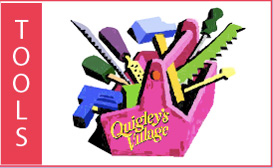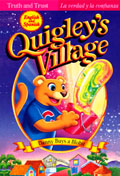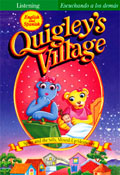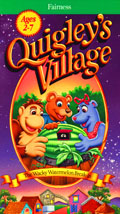


 |
TOOLS to help you get going
Teaching values to your children may feel a bit daunting if you have not done the research or taught them before. The team of Quigley's Village did all the for you and wants to give you tools and resources to help you!
Here is some practical information to help you teach your children about the following values:
Teaching the Value of Trust & Trust
The incident I had with my son at age 3 was the reason that we began this adventure of helping parents teach values to their kids. Understanding the meaning of the words “truth” and “lie” are often based on a child’s age and maturity.
Young children whose needs are met learn that the world is trustworthy. They learn to feel secure; they are willing to explore and discover. Without trust, fear develops, and fear breeds lies. Youngsters sometimes test the difference between reality and fantasy. Adults should tell the truth and expect children to tell the truth in return. We want little ones to trust God. Adults are their first examples of what God is like. We must be trustworthy so that children can learn how to trust the Lord. You might want to avoid using the words, "truth" and "lie," because these are difficult ideas for young children to understand. Talk about "answers to our questions" for "truth" and "made-up stories" for "lies." Tell anecdotes and tales to your children and comment that they are "made-up stories." If little ones do tell lies, see their mistakes as learning experiences. Tell them that you still love them.
Activities to Teach about Truth & Trust:
- Go on a trust walk. You start as the leader: your kid wears a blindfold. You take your child on a walk. He is fully dependent on you. The object is to build truth between you and your child so don’t play tricks. Then switch roles. You now have to trust him to lead you. It is a great opportunity to explain how trust and telling the truth are linked together.
- Draw a picture about the events of the day.
- Play "Do Like Me." Player 1 says, "Everybody repeat after me: I like you; you like me. Do like me, on one, two, three! Okay everybody, _____________________!" (Fill in the blank with an action, such as laugh, fall down, give a hug.) Player 1 selects the next leader.
Quigley's Village Recommended Video on Truth and Trust
 The video that ties into this value is "Danny Buys a Blobit." Mr. Quigley sends Danny Lion to the store to buy decorations for the Fun Day Picnic. When he gets to the store he sees a Blobit on sale. A Blobit is a toy that grows when you put it in water. Since he spent the money he was given for decorations on buying the blobit he tells one lie after another to cover up. He finally buries the Blobit. Then it rains and he is found out when the Blobit grows to 7 feet tall. Mr. Quigley then deals with Danny and telling a lie. Many parents have found Mr. Quigley’s way of dealing with Danny helpful in their parenting situations regarding telling the truth. The video that ties into this value is "Danny Buys a Blobit." Mr. Quigley sends Danny Lion to the store to buy decorations for the Fun Day Picnic. When he gets to the store he sees a Blobit on sale. A Blobit is a toy that grows when you put it in water. Since he spent the money he was given for decorations on buying the blobit he tells one lie after another to cover up. He finally buries the Blobit. Then it rains and he is found out when the Blobit grows to 7 feet tall. Mr. Quigley then deals with Danny and telling a lie. Many parents have found Mr. Quigley’s way of dealing with Danny helpful in their parenting situations regarding telling the truth.
During the video, you may want to occasionally stop it and ask your children, "What do you think you would do (or feel or say) in this story?" Then, watch how the program ends.
After the video, ask your children to share what they thought about the story. Which character was their favorite? Which character was most like them? In what ways?
Additional activities to do after the video could be:
- Have a Fun Day Picnic. Each family member provides something: a game, the food, decorations, a story, a sign.
- Make silly putty (similar to a Blobit!) Mix well: 1 cup of Elmer's white glue and 1/2 cup of Sta-Flo liquid starch. Let it dry in the bowl; store in an airtight container. Use on smooth surfaces.
- Make a box camera, just like the one Bubba makes for the Fun Day Picnic. Put a hole in each end of a shoebox. Fill in one hole, with a hollowed-out styrofoam cup for the camera lens. Leave the other hole for an eyepiece.
- Learn and sing together one of the songs from "Always Tell the Truth."
Back to Top
Teaching the Value of Listening:
Youngsters have difficulty in remembering long lists of abstract things, that is, things that they are not actually able to see and touch at that moment. They are not detached thinkers; they cannot think about thinking. Children use and understand language only in concrete terms. Children do not understand metaphors, symbols, or abstract ideas. Parents will help by making positive comments to children. Give them messages of approval and care. When you have to say "no," say it kindly but firmly. Also, enforce limits consistently. Let your "no" mean "no," and your "yes" mean "yes."
Activities to do to learn about Listening:
- Encourage your children's development of listening and memory skills by playing memory games. With the family, take turns completing the phrase, "I'm going on a sleepover and I'm taking a ___________________." As each family member takes their turn, they remember and repeat all the belongings mentioned by other family members. To make the game more difficult for older children, require that each repeats the list in order or that each item begins with the same letter of the alphabet or that each item begin with a sequential letter of the alphabet.
- Have your older children interview other people about the responses they've had to prayers to God. Children can ask other people if they feel that God has heard their prayers and why they believe so.
- Have a family meeting where you talk about the importance of listening carefully and remembering what people say. Create a family story, such as "The Day You Were Born" or "The First Day of School."
- Tell each other about one of the traditions in your family. How do these traditions pass along the family's stories?
- Learn a few signs in American Sign Language. Good signs to learn include: God, Love, and You.
- Develop a habit of saying positive things to each family member and be specific. "Wow! You did a great job of putting away your toys!" Here are some words to include when giving praises to children:
- Wow
- Way to Go
- Super
- You're Special
- Outstanding
- Excellent
- Great
- Good
|
- Well Done
- Fantastic
- Now You've Got It
- Super Star
- Nice Work
- Looking Good
- Marvelous
- You're Important
- You're a Joy
|
- You're Precious to Me
- What a Good Listener
- You are Fun to be With
- You're a Good Friend
- You Mean a Lot to Me
- I Like You
- Awesome
- You Make Me Happy
|
Quigley's Village Recommended Video on Listening:
 The video that ties into this value is "Spike and the Silly Mixed-Up Sleepover." In this video, Spike learns what happens when she does not listen carefully. She does not pay attention when her dad suggests what she should take to Lemon's house for the sleepover. She realizes that if she had listened better to her dad, she would have had everything she needed for a pleasant stay. The video that ties into this value is "Spike and the Silly Mixed-Up Sleepover." In this video, Spike learns what happens when she does not listen carefully. She does not pay attention when her dad suggests what she should take to Lemon's house for the sleepover. She realizes that if she had listened better to her dad, she would have had everything she needed for a pleasant stay.
During the video, you may want to occasionally stop it and ask your children, "What do you think you would do (or feel or say) in this story?" Then, watch how the program ends.
After the video, ask your children to share what they thought about the story. Which character was their favorite? Which character was most like them? In what ways?
Additional activities to do after the video could be:
- Younger children can listen to the video program for concrete things. For example, have your children try to remember all the things that Spike needs to take to the sleepover or all the things that Dexter needs for his paint job.
- Learn and sing together one of the songs from "Spike and the Silly Mixed-Up Sleepover."
Back to Top
Teaching the Value of Fairness:
The phrase “That’s Not Fair” seems to have become an all pervasive phrase connected to raising kids. Because of that we picked fairness as one of the first three video programs that we did.
Young children usually define what is "fair" according to their own needs and desires of the moment. Parents, however, do not need to give in to a youngster's definition of fairness. Each little one is an individual, created by God with a one-of-a-kind personality and a special learning style. Therefore, parents need to be able to respond to the unique needs of each child, without necessarily setting absolute standards according to age.
If youngsters compare the rules in their home to the rules in a friend's home, parents can simply explain that your family just doesn't have the same rules. However, be sure to let your little ones know you're willing to listen to how they feel about things, restate the complaint, and say: "Thanks for letting me know how this situation looks to you."
In disagreements between siblings it is important to avoid becoming a referee. One way to help children problem-solve is to ask: "What are some possible reactions to this situation?" Then, together, you can list some solutions and decide on a course of action. Remember that adults are models for children's early understanding of God. Sometimes we think the Lord is unfair, but God intends every situation for our good.
Activities to do to learn about Fairness:
- Create "lifelines" for each family member. List duties and freedoms they acquired at various ages. They are different as they get older. Fill in the blanks in this sentence: "When I was ____ (age), I could ______________________ (something you did then). When I am _____ (age), I will _________________________ (something you'll do).
- Play the "Take Turns" game! Player 1 makes an animal noise, which the others repeat. Player 1 selects another player, who makes an animal noise, which the others repeat. When everyone has had a turn. You could take turns making funny faces or naming friends.
- Work together as a family to make fruit salad. Even 3 year-olds can help cut fruit with plastic knives, under supervision.
Quigley's Village Recommended Video on Fairness:
 The video that ties into this value is "The Wacky Watermelon Break-In." In this video, Spike, Danny and Bubba let their imaginations run wild as they become space farmers. All summer long they’ve tended to their “space garden” eagerly anticipating the harvest of a very large watermelon. As Mr. Quigley begins to slice open the watermelon, they are shocked and disappointed to discover someone has made a home out of it. Important lessons on fairness and sharing are taught. The video that ties into this value is "The Wacky Watermelon Break-In." In this video, Spike, Danny and Bubba let their imaginations run wild as they become space farmers. All summer long they’ve tended to their “space garden” eagerly anticipating the harvest of a very large watermelon. As Mr. Quigley begins to slice open the watermelon, they are shocked and disappointed to discover someone has made a home out of it. Important lessons on fairness and sharing are taught.
During the video, you may want to occasionally stop it and ask your children, "What do you think you would do (or feel or say) in this story?" Then, watch how the program ends.
After the video, ask your children to share what they thought about the story. Which character was their favorite? Which character was most like them? In what ways?
Additional activities to do after the video could be:
- Encourage your child's imaginative development by providing props to help children engage in make-believe play. For example, in the imaginative adventure on the video, Spike and Danny and Bubba became "space farmers." You might want to provide props for youngsters to pretend they are mail carriers, like Molly. Collect used envelopes, an old typewriter, used stamps, tape, boxes, paper, a large handbag, a hat, a large box for a mailbox, rubber stamps and pad, paper, pencils and crayons.
- Learn and sing together one of the songs from "It Really Isn't Fair!"
Back to Top
If you would like to learn more about teaching values to your children and practical lessons to do so, make sure to check out the Learn More Page.

|
